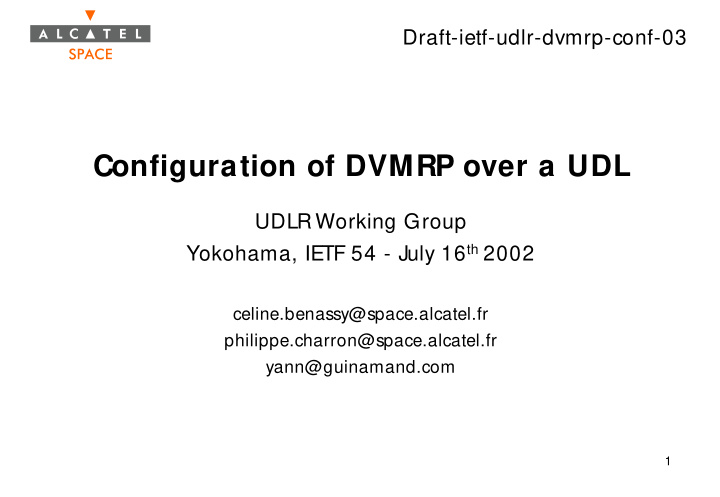



Draft-ietf-udlr-dvmrp-conf-03 Configuration of DVMRP over a UDL UDLR Working Group Yokohama, IETF 54 - July 16 th 2002 celine.benassy@space.alcatel.fr philippe.charron@space.alcatel.fr yann@guinamand.com 1
Draft-ietf-udlr-dvmrp-conf-03 Sum-up ▼ To offer Multicast services on network with a UDL based on a satellite network : DVMR Pv3 as routing protocol � Feed and R eceivers are DVMR Pv3 routers � A high number of receivers connected to the UDL ▼ To suggest an optimized configuration of DVMR P on R eceiver � To reduce the number of DVMR P messages sent from R eceivers to the Feed via the GR E tunnel � “Active R eceiver”: a standard DVMR Pv3 implementation � “Passive R eceiver”: a NON standard DVMR P implementation ▼ I-D based on an experiment 2
Draft-ietf-udlr-dvmrp-conf-03 Network architecture UDL modem Receiver DVB-S LAN Gateway PSTN/ R NIS Feed Access router ISP Receiver network Multicast LAN data GR E server TUNNEL GR E TUNNEL Internet MBONE
Draft-ietf-udlr-dvmrp-conf- 02 ➜ 03 Changes 02 ➜ ➜ 03 ➜ ➜ ▼ Changes of Abstract and Introduction � To describe how DVMR Pv3 works on a network with a UDL with a return link based on LLTM � To suggest a configuration of DVMR Pv3 routers connected to the UDL more adapted and optimized ▼ Addition of a section “DVMR Pv3 implementation“ (sect. 2.2) � DVMR Pv3 mrouted 3.9b3 on FreeBSD 3.4-R elease
Draft-ietf-udlr-dvmrp-conf- 02 ➜ 03 Changes 02 ➜ ➜ 03 ➜ ➜ ▼ Sect. 2.4 “Passive mode configuration on receivers” � To stress that a NEW parameter needs to be developed in the standard DVMR Pv3 implementation � switch_uni_bi < group IP address> • < group IP address> : not a multicast address related to a multicast group session • Example: switch_uni_bi 224.5.6.7 � UDL interface on receiver has be defined as unidirectional Example: Phyint dvb0 one_way
Draft-ietf-udlr-dvmrp-conf- 02 ➜ 03 Changes 02 ➜ ➜ 03 ➜ ➜ ▼ Wording of Sect. 2.4 “When and how to switch between active and passive mode” � WHEN to switch to active mode ? On the LAN interface of a passive receiver: � There is a subscriber to a multicast session not forwarded by the Feed over the UDL � A End-User wishes to participate to a multicast session (to send multicast data) � HOW to switch between modes ? � To active mode: upon reception of an IGMP join message to < group_IP_address> (“switch_uni_bi” address) � To passive mode: when there is no more member for this particular group on the LAN interface
Draft-ietf-udlr-dvmrp-conf- 02 ➜ 03 Changes 02 ➜ ➜ 03 ➜ ➜ ▼ Sect. 3 Domains of application � Section 3.1 Application using a R MT protocol � Detail about NACK: NACK are sent in multicast by the R eceiver • The NACK is forwarded by the Feed over the UDL and to source • To prevent other R eceivers on the UDL from sending the same NACK
Draft-ietf-udlr-dvmrp-conf- 02 ➜ 03 Changes 02 ➜ ➜ 03 ➜ ➜ ▼ Sect. 4 Other network architectures : Introduction: Why do we suggest 2 other network architectures ? � 1 st architecture: An active receiver on the same LAN as the Feed � To propose a network with an active receiver under satellite owner’s control • To be sure that at least one active receiver is on the UDL allowing a high number of receivers on the UDL to be in passive mode and to receive multicast sessions � 2 nd architecture: Both Feed and R eceivers have an access to the Mbone � To suggest a configuration to prevent active R eceiver from sending multicast data via the GR E tunnel to the Feed and to the UDL � More optimized to use the Mbone
Draft-ietf-udlr-dvmrp-conf-03 Next Steps ▼ Comments or questions ? ▼ Goal: to submit this I-D as an informational R FC � Is it ready ? � How to proceed ?
Recommend
More recommend